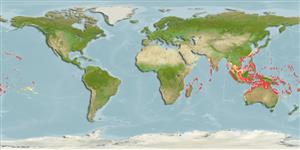Common names from other countries
>
Holocentriformes (Squirrelfishes, soldierfishes) >
Holocentridae (Squirrelfishes, soldierfishes) > Myripristinae
Etymology: Myripristis: Greek, myros, -ou = male of morey eel + Greek, pristis = saw (Ref. 45335).
More on author: Valenciennes.
Environment: milieu / climate zone / depth range / distribution range
Ecologie
marien rifbewoner; diepte 0 - 100 m (Ref. 128797). Tropical; 32°N - 32°S
Indo-Pacific: East Africa south to Natal, South Africa (except Red Sea, Gulf of Aden, Persian Gulf, Indian coast) and east to French Polynesia and the Hawaiian Islands; north to Tosa Bay, Shikoku (Japan), south to the Great Barrier Reef and Lord Howe Island.
Grootte / Gewicht / Leeftijd
Maturity: Lm ? range ? - ? cm
Max length : 26.0 cm TL mannelijk / geslacht onbekend; (Ref. 48635); common length : 16.0 cm TL mannelijk / geslacht onbekend; (Ref. 30573)
Dorsale stekels (totaal) : 11; Dorsale zachte stralen (totaal) : 15 - 17; Anale stekels: 4; Anale zachte stralen: 14 - 16. Body red dorsally, silvery pink below LL; reddish brown bar from upper end of gill opening to base of pectoral fins; fins red except for spinous dorsal which is translucent red basally and broadly yellow distally (Ref. 4201). Has smaller scales than most other similar species and the higher number along the body is quite obvious (Ref. 48635).
Lives in subtidal reef flats, also in lagoon and seaward reefs below the surge zone to depths of at least 26 m. Often occurs in large aggregations during the day in areas of rich foliaceous or cavernous coral growth (Ref. 30573). Benthopelagic (Ref. 58302). Feeds on plankton such as crab larvae. Caught at night (Ref. 30573).
Levenscyclus en paargedrag
Maturities | Voortplanting | Spawnings | Egg(s) | Fecundities | Larven
Randall, J.E. and D.W. Greenfield, 1996. Revision of the Indo-Pacific holocentrid fishes of the genus Myripristis, with descriptions of three new species. Indo-Pac. Fish. (25):61 p. (Ref. 12419)
Status op de Rode Lijst van het IUCN (Ref. 130435)
CITES (Ref. 128078)
Not Evaluated
Gevaar voor de mens
Harmless
Gebruik door de mens
Visserij: van minder commercieel belang; Aquarium: Commercieel
Tools
Speciale rapporten
Download XML
Internetbronnen
Estimates based on models
Preferred temperature (Ref.
115969): 25.2 - 28.9, mean 27.8 (based on 640 cells).
Fylogenetische diversiteitsindex (Ref.
82804): PD
50 = 0.5000 [Uniqueness, from 0.5 = low to 2.0 = high].
Bayesian length-weight: a=0.02188 (0.01296 - 0.03693), b=3.12 (2.98 - 3.26), in cm Total Length, based on LWR estimates for this species & Genus-body shape (Ref.
93245).
Trofisch niveau (Ref.
69278): 3.4 ±0.2 se; based on diet studies.
Weerstandsvermogen (Ref.
120179): Hoog, minimale populatieverdubbelingstijd minder dan 15 maanden (Preliminary K or Fecundity.).
Fishing Vulnerability (Ref.
59153): Low vulnerability (16 of 100).
